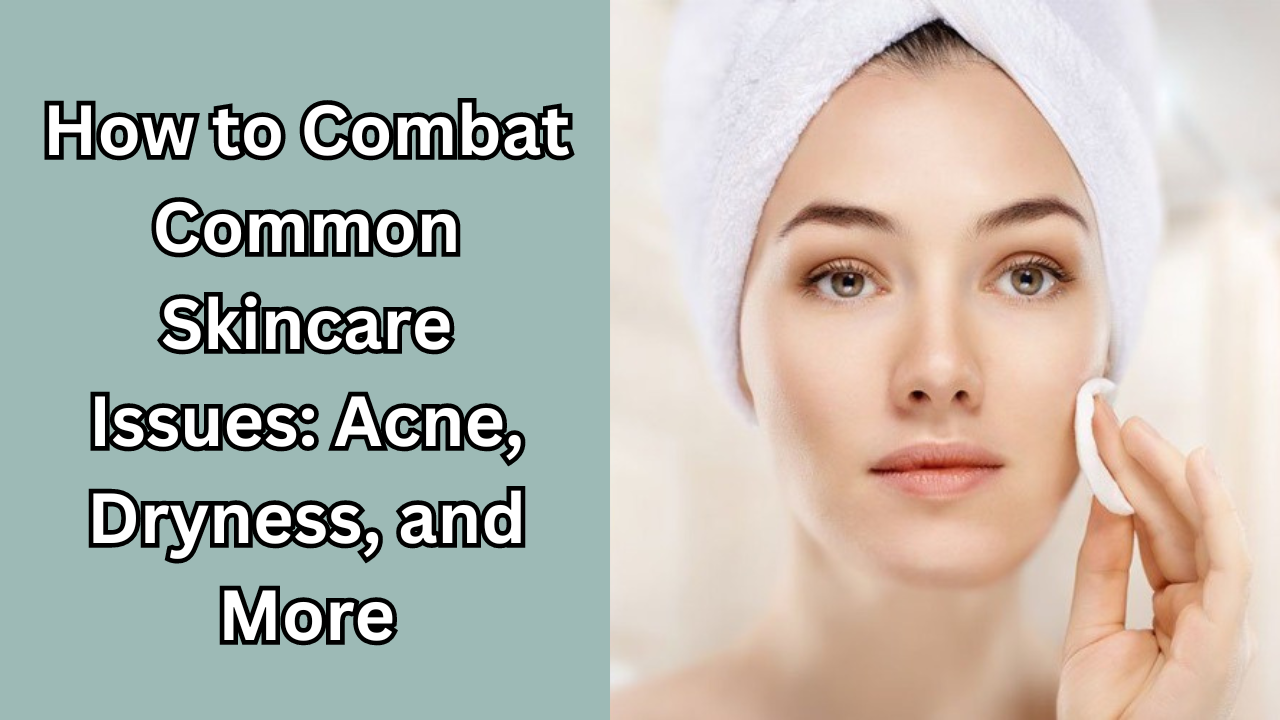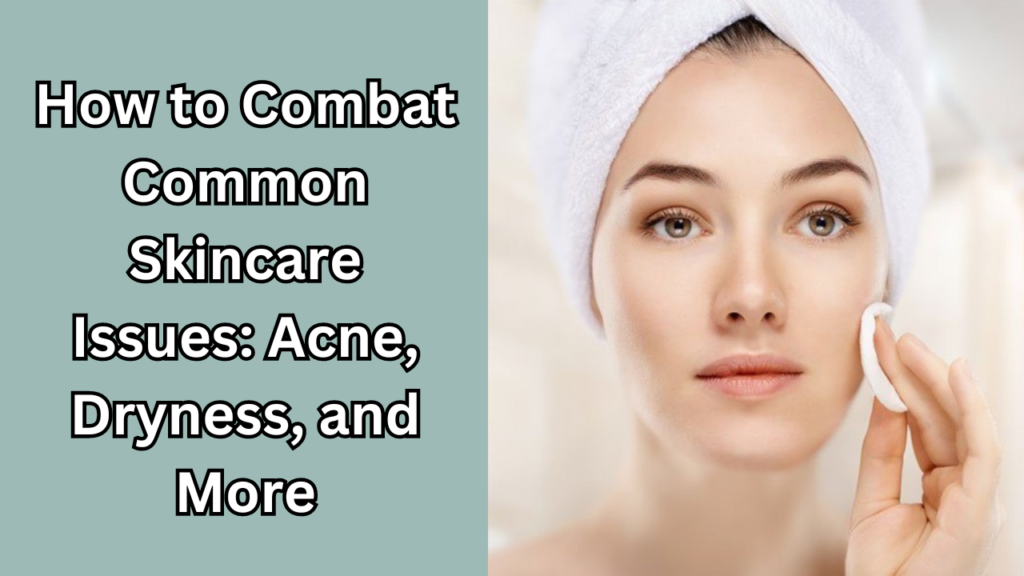

Table of Contents
Introduction
In the quest for radiant and healthy skin, many of us encounter common skincare issues that can impact our confidence and overall well-being. From persistent acne and debilitating dryness to oily patches and sensitive reactions, these skin concerns are not only widespread but also varied in their causes and effects. Addressing these problems effectively is crucial for maintaining not just a clear complexion but also skin health that reflects your inner vitality.
Brief Overview of Common Skincare Issues
Among the most prevalent skincare issues, acne stands out as a major concern for both teenagers and adults. Characterized by pimples, blackheads, and cysts, acne can affect self-esteem and be a source of persistent frustration. Dryness, on the other hand, manifests as flaky, itchy skin and can result from environmental factors or inadequate hydration. Oily skin, marked by excess sebum production, often leads to a shiny appearance and can contribute to clogged pores and acne. Sensitive skin, which reacts easily to environmental changes or certain products, can cause discomfort and redness, making it a delicate issue to fashion.
Importance of Addressing These Problems
Tackling these common women skincare issues is not merely about achieving a flawless appearance; it’s about ensuring that your skin functions optimally. Effective management of acne can prevent scarring and reduce inflammation, while addressing dryness can alleviate discomfort and prevent further skin damage. Controlling oily skin helps minimize the risk of breakouts and ensures a balanced complexion, while caring for sensitive skin protects it from irritation and maintains its natural resilience. By understanding and addressing these concerns, you can enhance both the health and appearance of your skin, leading to a more confident and comfortable you.
Understanding Acne
Acne is a multifaceted skin condition that primarily affects the face, back, and shoulders, presenting itself through a range of symptoms including pimples, blackheads, and cysts. This condition arises when hair follicles become clogged with excess sebum (oil) and dead skin cells, creating an environment conducive to bacterial growth. The inflammation that results can cause the characteristic red, swollen lesions. Acne is commonly associated with hormonal fluctuations, such as those experienced during puberty, menstruation, or pregnancy, but it can also be exacerbated by stress, dietary factors, and the use of certain skincare products. Understanding the underlying causes and triggers of acne is crucial for developing an effective treatment strategy, whether through topical treatments, lifestyle adjustments, or a combination of both.
What is Acne?
Acne is a common skin condition characterized by the formation of pimples, blackheads, whiteheads, and cysts. It primarily affects areas with high concentrations of sebaceous glands, such as the face, back, and shoulders. Acne lesions are classified into several types:
- Blackheads: These are open comedones where the follicle is clogged with oil and dead skin cells, turning dark due to oxidation.
- Whiteheads: Closed comedones are similar to blackheads but remain under the skin’s surface, appearing as small, white bumps.
- Papules: Small, inflamed bumps that are often red and tender.
- Pustules: These are similar to papules but contain pus, giving them a white or yellowish appearance.
- Nodules: Large, painful lumps that form beneath the skin’s surface.
- Cysts: Deep, painful, pus-filled lesions that can cause scarring.
Understanding these types helps in identifying the most appropriate treatment and management strategies.
Causes of Acne
Acne develops from a combination of factors, including:
- Hormonal Changes: Hormones such as androgens increase the size and activity of sebaceous glands, leading to excess oil production. This is particularly evident during puberty, menstruation, pregnancy, or conditions like polycystic ovary syndrome (PCOS).
- Diet: Certain foods, especially those high in sugars and dairy, have been linked to worsening acne in some individuals. However, the relationship between diet and acne is still being studied.
- Stress: High-stress levels can exacerbate acne by triggering hormonal imbalances and increasing oil production.
- Skin Care Products: Comedogenic (pore-clogging) products can contribute to acne by trapping oil and dead skin cells in the pores.
- Genetics: A family history of acne can increase the likelihood of developing it, suggesting a genetic predisposition.
Effective Treatments
Managing acne often requires a multifaceted approach that includes:
- Topical Treatments: These are applied directly to the skin and include:
- Benzoyl Peroxide: Reduces bacteria and helps unclog pores by exfoliating dead skin cells.
- Salicylic Acid: Penetrates the pores to dissolve dead skin cells and reduce inflammation.
- Retinoids: Promote cell turnover and prevent clogged pores, with options ranging from over-the-counter to prescription-strength formulations.
- Oral Medications: For more severe cases, doctors may prescribe:
- Antibiotics: Help reduce inflammation and bacterial growth. Common examples include tetracycline and doxycycline.
- Retinoids: Oral forms, like isotretinoin, are highly effective for severe, cystic acne but require careful monitoring due to potential side effects.
- Lifestyle and Dietary Changes: Adopting a healthy lifestyle can complement treatment:
- Balanced Diet: Reducing intake of high-glycemic foods and dairy may help some individuals.
- Stress Management: Techniques such as exercise, meditation, and adequate sleep can help manage stress levels.
- Proper Skin Care: Using non-comedogenic products and maintaining a consistent skincare routine can prevent new breakouts.
By combining these treatments with lifestyle adjustments, many individuals can effectively manage their acne and achieve clearer skin.
Managing Dry Skin
Dry skin, or xerosis, can be both uncomfortable and unsightly, characterized by rough, flaky patches and a tendency to feel tight or itchy. Effective management of dry skin begins with adopting a moisturizing regimen that includes hydrating products rich in ingredients like hyaluronic acid, glycerin, and ceramides, which help restore and retain moisture. It is essential to use gentle, non-stripping cleansers and avoid hot water, which can further deplete skin’s natural oils. Incorporating a humidifier into your environment can add moisture to the air and help prevent skin from becoming overly dry. Additionally, maintaining a balanced diet with adequate hydration supports skin health from the inside out. By following these practices and adjusting beauty skincare routine to address the underlying causes of dryness, you can alleviate discomfort and improve the overall texture and appearance of your skin.
Causes of Dry Skin
Dry skin can be attributed to a variety of factors, each contributing to its lack of moisture and subsequent discomfort. Environmental factors such as low humidity, cold weather, and exposure to harsh winds can strip the skin of its natural oils, leading to dryness. Genetics also play a role; individuals with a family history of dry skin may be more predisposed to developing it themselves. Additionally, certain skin conditions like eczema, psoriasis, or dermatitis can impair the skin’s ability to retain moisture, resulting in chronic dryness and irritation. Identifying these causes is crucial for effectively managing and preventing dry skin.
Best Practices for Hydration
To combat dry skin, incorporating effective hydration strategies is essential. Moisturizers are the cornerstone of any dry skin regimen. Products containing hyaluronic acid draw moisture from the environment into the skin, while ceramides help repair and reinforce the skin’s natural barrier, preventing further moisture loss. In addition to commercial moisturizers, home remedies can provide natural relief. For example, honey is a natural humectant that attracts and retains moisture, while oatmeal masks soothe and hydrate the skin, providing relief from dryness and irritation.
Preventive Measures
Preventing dry skin involves making mindful adjustments to your daily routine. Avoiding harsh soaps and hot water is crucial, as these can strip the skin of its natural oils and exacerbate dryness. Opt for gentle, hydrating cleansers that maintain the skin’s moisture balance. Using a humidifier can also help by adding moisture to the air, which is especially beneficial in dry, heated indoor environments during the winter months. By incorporating these preventive measures into your routine, you can help maintain skin hydration and reduce the risk of developing dry skin.
Addressing Oily Skin
Oily skin, marked by excessive sebum production, can lead to a shiny complexion and an increased risk of clogged pores and acne. To effectively manage oily skin, it is important to adopt a balanced skincare routine. Begin with a gentle, oil-free cleanser that helps remove excess oil without stripping the skin of its natural moisture. Incorporating oil-absorbing products, such as those containing salicylic acid or clay masks, can help regulate oil production and minimize shine. Additionally, using lightweight, non-comedogenic moisturizers ensures that skin remains hydrated without contributing to excess oil. Regular use of blotting papers can help manage oil throughout the day, providing a quick solution for controlling shine. By implementing these practices, you can achieve a more balanced complexion and reduce the potential for breakouts associated with oily skin.
Causes of Oily Skin
Oily skin is influenced by a combination of factors that stimulate excess sebum production. Genetics play a significant role; if oily skin runs in your family, you might be more prone to it. Hormones also have a major impact, particularly during puberty, menstruation, or pregnancy, when fluctuations can increase oil production. Additionally, diet can contribute to oily skin; high-glycemic foods and dairy products may exacerbate oiliness and lead to breakouts. Understanding these causes helps in targeting the right treatments and making effective adjustments to manage oily skin.
Effective Treatments
Managing oily skin requires a strategic approach with targeted treatments. Oil-control products are essential, including mattifying lotions that help reduce shine and absorb excess oil throughout the day. Clay masks are also effective as they draw out impurities and control oil production. Adjusting your skincare routine is crucial; use gentle cleansers formulated to remove excess oil without disrupting the skin’s natural balance. Incorporating these treatments can help control oil levels and maintain a more matte complexion.
Lifestyle Adjustments
In addition to topical treatments, making lifestyle adjustments can further manage oily skin. Diet modifications can make a significant difference; reducing the intake of high-glycemic foods and processed sugars can help regulate oil production. Stress management is also important, as high stress levels can trigger hormonal changes that increase oil production. Practices such as regular exercise, adequate sleep, and stress-reducing techniques like meditation can contribute to better skin health and reduced oiliness.
Treating Sensitive Skin
Sensitive skin requires a gentle and thoughtful approach to avoid irritation and maintain its delicate balance. To effectively treat sensitive skin, opt for fragrance-free and hypoallergenic skincare products designed specifically for sensitive types. Look for ingredients such as aloe vera, chamomile, and niacinamide, which are known for their soothing and anti-inflammatory properties. Avoid harsh exfoliants and aggressive treatments that can compromise the skin barrier. Incorporating barrier-repair moisturizers that contain ceramides or hyaluronic acid can help strengthen the skin’s natural defenses and lock in moisture. Additionally, always perform a patch test when trying new products to ensure they do not trigger a reaction. By taking these precautions and focusing on calming, protective products, you can effectively manage sensitive skin and reduce the risk of flare-ups.
Identifying Sensitive Skin
Sensitive skin is characterized by a heightened reaction to various stimuli, leading to noticeable symptoms such as redness, itching, burning, and dry patches. Common triggers include harsh skincare products, extreme temperatures, and environmental pollutants. Individuals with sensitive skin may also react adversely to certain ingredients, including fragrances, dyes, and alcohols. Identifying these symptoms and triggers is crucial for managing sensitive skin and selecting appropriate treatments that avoid exacerbating these reactions.
Gentle Skincare Routines
To care for sensitive skin, a gentle skincare routine is essential. Opt for fragrance-free products that minimize the risk of irritation and allergic reactions. Avoid ingredients known to be harsh or irritating, such as alcohol, sulfates, and strong exfoliants. Choose cleansers and moisturizers with mild, soothing ingredients that support the skin’s barrier without disrupting its natural balance. Consistency with a simplified, non-irritating routine can help maintain skin comfort and resilience.
Soothing Remedies
In addition to a gentle routine, incorporating soothing remedies can provide relief for sensitive skin. Natural ingredients like aloe vera offer excellent calming benefits, reducing redness and irritation while hydrating the skin. Chamomile is another effective ingredient known for its anti-inflammatory properties, helping to soothe and calm sensitive skin. Using these ingredients in masks or as part of your daily skincare routine can enhance comfort and reduce sensitivity, promoting a more balanced and resilient complexion.
Combating Hyperpigmentation
Hyperpigmentation, characterized by dark spots or patches on the skin, can result from various factors including sun exposure, acne scars, and hormonal changes. To effectively combat hyperpigmentation, incorporating brightening agents into your skincare routine is key. Ingredients like vitamin C, niacinamide, and retinoids can help inhibit melanin production and promote cell turnover, leading to a more even skin tone. Sunscreen is crucial, as protecting the skin from UV rays prevents further darkening and allows existing spots to fade more efficiently. Additionally, gentle exfoliation with chemical exfoliants such as alpha hydroxy acids (AHAs) can help remove dead skin cells and reveal fresher, more even-toned skin. By combining these treatments with consistent sun protection, you can effectively reduce hyperpigmentation and achieve a brighter, more uniform complexion.
Understanding Hyperpigmentation
Hyperpigmentation occurs when certain areas of the skin produce excess melanin, leading to darkened spots or patches. There are several types of hyperpigmentation, including sun spots, which are caused by prolonged exposure to ultraviolet (UV) radiation and typically appear on sun-exposed areas like the face, hands, and shoulders. Melasma is another common form, often triggered by hormonal changes and frequently seen during pregnancy or with the use of birth control pills. Other forms include post-inflammatory hyperpigmentation (PIH), which arises after skin injuries or inflammation, such as acne or eczema. Understanding these types helps in selecting the most appropriate treatments for addressing the specific type of hyperpigmentation.
Treatments and Solutions
Addressing hyperpigmentation involves a combination of topical treatments and professional interventions. Topical treatments include vitamin C, which brightens the skin and inhibits melanin production, and retinoids, which promote cell turnover and help fade dark spots. Other effective ingredients include niacinamide, known for its anti-inflammatory and skin-lightening properties, and hydroquinone, which reduces melanin production. For more advanced cases, professional options such as chemical peels can exfoliate the skin’s surface and improve pigmentation, while laser therapy targets melanin deposits to break them up and reduce discoloration. Combining these treatments with diligent sun protection enhances their effectiveness and helps prevent new spots from forming.
Handling Aging Skin
As skin ages, it naturally undergoes changes such as reduced elasticity, increased dryness, and the development of fine lines and wrinkles. To effectively handle aging skin, it’s important to adopt a comprehensive skincare regimen that addresses these concerns. Hydrating products with ingredients like hyaluronic acid and ceramides help restore moisture and strengthen the skin barrier, while retinoids and peptides promote collagen production and improve skin texture. Incorporating antioxidants such as vitamin C can protect against environmental damage and brighten the complexion. Regular use of sunscreen is crucial to shield the skin from UV radiation, which accelerates aging. Additionally, gentle exfoliation with alpha hydroxy acids (AHAs) can help remove dead skin cells and reveal a more youthful, radiant surface. By combining these strategies, you can effectively manage the signs of aging and maintain a healthy, glowing complexion.
Common Signs of Aging
As the skin ages, several noticeable changes occur that reflect the passage of time. Wrinkles and fine lines are among the most prominent signs, resulting from the breakdown of collagen and elastin fibers, which diminish skin’s ability to remain firm and supple. Loss of elasticity leads to sagging and a decrease in skin’s resilience, making it less able to bounce back after stretching or movements. Additionally, aging skin may show increased dryness and thinning, which can exacerbate the appearance of fine lines and create a rough texture. Recognizing these signs helps in tailoring an effective skincare approach to address and mitigate the visible effects of aging.
Anti-Aging Skincare
To combat the visible signs of aging, incorporating specific anti-aging ingredients into your skincare routine can be highly effective. Retinol is a well-known ingredient that boosts collagen production and enhances cell turnover, smoothing out fine lines and improving skin texture. Peptides also play a crucial role by supporting skin repair and maintaining its structural integrity. Antioxidants like vitamin C help protect the skin from environmental damage and brighten the complexion. Alongside these treatments, preventive measures such as diligent sun protection are essential to shield the skin from harmful UV rays that accelerate aging. Regular use of broad-spectrum sunscreen helps prevent further damage and preserves the benefits of anti-aging products.
Lifestyle Factors
Maintaining a youthful appearance is not only about skincare but also involves healthy lifestyle factors. Nutrition plays a significant role; a diet rich in antioxidants, healthy fats, and vitamins supports skin health and helps combat oxidative stress. Hydration is equally important, as drinking plenty of water keeps the skin plump and resilient. Sleep is another critical factor, as it allows the skin to repair and regenerate overnight. Ensuring adequate rest can help reduce the appearance of dark circles and promote a more refreshed, glowing complexion. By integrating these lifestyle habits with a robust skincare routine, you can enhance your skin’s health and appearance as you age.
Dealing with Redness and Rosacea
Managing redness and rosacea requires a multifaceted approach to alleviate symptoms and prevent flare-ups. Rosacea is characterized by persistent facial redness, visible blood vessels, and sometimes acne-like bumps, often triggered by factors like sun exposure, stress, and certain foods. Effective treatment typically involves a combination of prescription medications and topical treatments to reduce inflammation and control symptoms. Topical antibiotics like metronidazole, and oral medications such as doxycycline, are commonly used to manage more severe cases. In addition to medical treatments, avoiding known triggers is crucial; this may include adjusting your diet to avoid spicy foods and alcohol, protecting your skin from extreme temperatures, and using gentle skincare products. By combining appropriate treatments with proactive trigger management, individuals with rosacea can better control their symptoms and improve their skin’s overall appearance.
Understanding Rosacea
Rosacea is a chronic skin condition characterized by persistent redness, visible blood vessels, and, in some cases, acne-like eruptions. Common symptoms include flushing, redness primarily on the cheeks, nose, chin, and forehead, and the appearance of small, red, pus-filled bumps. In severe cases, it can also cause thickening of the skin, especially around the nose. The causes of rosacea are not fully understood, but it is believed to involve a combination of genetic and environmental factors. Possible triggers include sun exposure, stress, hot beverages, spicy foods, and alcohol, which can exacerbate symptoms. Understanding these aspects is crucial for effective management and treatment of rosacea.
Treatment Options
Managing rosacea typically involves a combination of prescription medications and topical treatments to reduce inflammation and control symptoms. Topical medications such as metronidazole or azelaic acid help decrease redness and inflammation by targeting the underlying causes of the condition. Oral antibiotics like doxycycline may be prescribed for more severe cases to reduce inflammation and control breakouts. Additionally, topical retinoids and brimonidine can help manage symptoms by reducing redness and improving skin texture. Consulting with a dermatologist is essential to determine the most appropriate treatment plan based on the severity and specific characteristics of your rosacea.
Managing Triggers
Effectively managing rosacea also involves identifying and avoiding triggers that can worsen the condition. Dietary adjustments can make a significant difference; common triggers include spicy foods, hot beverages, and alcohol, which may exacerbate redness. Maintaining a balanced diet with anti-inflammatory foods, such as fruits, vegetables, and whole grains, can support overall skin health. Environmental factors also play a role; protecting the skin from extreme temperatures, using gentle, non-irritating skincare products, and applying broad-spectrum sunscreen can help minimize flare-ups. By being mindful of these triggers and incorporating appropriate preventive measures, you can better manage rosacea and maintain more stable skin.
Combining Treatments for Multiple Issues
Effectively managing multiple skincare concerns, such as acne, dryness, and sensitivity, requires a thoughtful approach to create a balanced regimen that addresses each issue without exacerbating others. Combining treatments involves selecting products and therapies that complement rather than conflict with each other. For example, integrating hydrating ingredients like hyaluronic acid can help manage dryness while using gentle, non-comedogenic products to prevent acne flare-ups. Additionally, incorporating soothing agents such as aloe vera can benefit sensitive skin while still addressing acne or hyperpigmentation. It’s essential to introduce new products gradually and monitor their effects to ensure that one treatment does not trigger or worsen another issue. Consulting with a dermatologist can provide personalized recommendations and ensure that your combined treatment plan is both effective and harmonious, leading to a more balanced and healthier complexion.
Developing a Personalized Skincare Routine
Creating a personalized skincare routine that addresses multiple concerns—such as acne, dryness, and sensitivity—requires a strategic approach to balance and efficacy. Start by identifying the primary issues you want to address and prioritize them based on severity and impact on your skin. Choose products that target each concern without overlapping too aggressively; for instance, use hydrating serums to combat dryness, while incorporating acne treatments that are gentle enough to avoid irritating sensitive skin. Incorporate soothing ingredients to help manage sensitivity and inflammation. Building a routine involves layering products correctly, typically starting with a gentle cleanser, followed by targeted treatments, and finishing with a moisturizer and sunscreen. Regularly reassess your routine to adapt to any changes in your skin’s condition or concerns. Tailoring your approach ensures that each issue is addressed effectively while maintaining overall skin health.
Product Layering and Avoiding Interactions
When managing multiple skincare concerns, proper product layering and avoiding interactions between different types of products are crucial for optimal results. Begin with a cleanser to remove impurities and prepare the skin for subsequent treatments. Apply serums or treatments for specific concerns, such as acne or hyperpigmentation, before applying a moisturizer to seal in hydration. To avoid adverse reactions, avoid layering products with potentially conflicting ingredients, such as combining retinoids with vitamin C, which can be irritating when used together. Allow each product to fully absorb before applying the next one to prevent pilling and ensure effective penetration. Always perform a patch test when introducing new products to monitor for any negative reactions. By adhering to these guidelines, you can create a cohesive routine that effectively addresses your skincare concerns without compromising skin health.
Conclusion
In summary, effectively addressing common skincare issues such as acne, dryness, sensitivity, and aging requires a comprehensive and personalized approach. Understanding each condition, from its causes to its symptoms, allows you to select appropriate treatments and develop a tailored skincare routine. Incorporating targeted products like hydrating serums, soothing agents, and effective anti-aging ingredients can significantly improve your skin’s health and appearance. It’s also crucial to manage triggers, avoid product interactions, and layer treatments properly to achieve optimal results. For a more precise and individualized approach, consider consulting with a skincare professional. Dermatologists can provide expert advice and personalized recommendations based on your unique skin type and concerns, ensuring that your skincare regimen is both effective and safe. Embracing this comprehensive approach will help you navigate and manage your skincare challenges with confidence.





